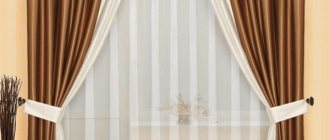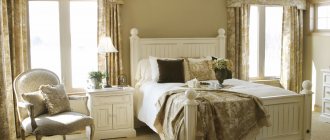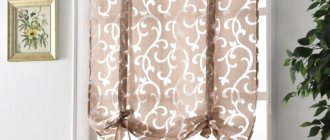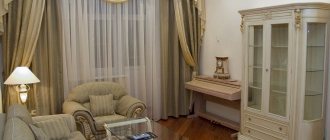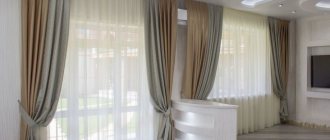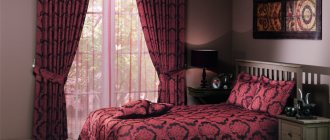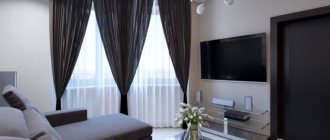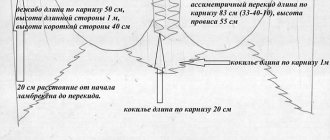How to sew curtains with your own hands.
2. Calculation of the width of the drawstring and the height of the frill. Using a tape measure, measure the diameter of the rod or rod and add an additional 3 cm (B). Decide how tall the frill will be and multiply that number by 2 (C).
3. Calculation of fabric consumption. To determine the overall cut length of the curtain (D), add together A, B and C and add 11.5 cm for seam allowance. By multiplying D by the number of panels used, you calculate the total amount of fabric consumed.
4. Cut and sew curtains. Cut the required number of panels according to the total cutting length D. Sew the curtains, making a hem 10 cm high.
5. Marking the drawstring and frill. Turn the top raw edge over to the wrong side 1.5 cm and press. From the fold line, use pins or tailor's chalk to mark the width of the drawstring (1/2 B) and the height of the frill (1/2 C). Fold the fabric along the frill line and iron.
What are cafe curtains?
A variant of straight curtains, which are fixed not above the opening, but in the middle, is called cafe curtains. They only cover the bottom of the window. This style is suitable for most rustic styles and is appropriate in a naive shabby chic design or in a Mediterranean interior. To make such curtains, natural fabrics with a chintz pattern (small pattern of flowers, polka dots) or with contrasting checks of different sizes are often used.
To work you will need:
- tailor's meter;
- chalk or pencil;
- textile;
- sewing machine;
- scissors.
Take measurements of width (with a gathering factor of at least 1.5) and length, add side and bottom allowances. For the drawstring (in the upper part of the curtain with your own hands), you need to calculate the diameter of the curtain rod. Multiply this value by 3 and add another 2-3 cm to the result for a loose fit. Take into account the hem allowance (1-1.5 cm). If you want to make a drawstring with a scallop, then add the double height of this decorative detail to the result of all previous calculations. Add the final value to the length measurement with allowance for hem at the bottom.
Read also: Types of lambrequins for the kitchen
We cut and sew curtains with our own hands in the following order:
- Mark a rectangle on the fabric according to the calculated measurements of width with allowance and length, taking into account the drawstring and comb (if needed). Cut 1 or 2 panels of cafe curtains.
- Fold and stitch the side seams.
- From the top cut, put down the drawstring allowance with or without a comb. Draw a straight line to mark the stitching line for the hem. Iron the allowance calculated for the hem on the fabric (1-1.5 cm from the cut).
- Divide the distance from the ironed fold to the straight line marked earlier by 2, draw a line and bend the fabric along it. The fold can be ironed if the curtain has a scallop.
- Align the ironed cut with the straight line, which marks the location of the hem stitch (see point 3). Make a stitch along the edge of the hem at a distance of 1-2 mm from the fold.
- If the drawstring is with a ridge, then from the place where the folded edge is sewn to the panel, set aside an amount equal to the diameter of the cornice multiplied by 3, and an allowance for a loose fit. Draw a new line from the wrong side of the panel. On top there will be a free part of the fabric folded in half - the comb.
- Hang the curtains on the curtain rod, align the lower edges of the adjacent curtains. Fold and pin. Remove from the bar, iron and stitch along the hem.
The curtain rod must be inserted into the drawstring. For ease of movement of the fabric along the cornice and bullae, an allowance for a loose fit is needed. The comb will create a frill that sticks up above the drawstring. It is not recommended to make a comb more than 5 cm, especially on thin fabrics: under its own weight it can bend and lose its decorative effect.
Both a simple straight curtain and a cafe style can be complemented with fringe or ruffles along the bottom edge and side cuts. A ruffle (frill) is made from the same or contrasting strip of fabric, the length of which is 2-2.5 times the length of the side where it needs to be sewn. The decor forms beautiful folds along the edge of the product.
Instead of a drawstring, decorative loops made of contrasting fabric can be sewn on the upper edge of both styles. They are cut separately, cutting out double-width strips. They are stitched along the edge, turned onto the face, and smoothed out. The sections are folded inwards by 0.5 cm and a stitch is made 1-2 mm from the edge. The loop can be attached using a large bright button or simply sewn on. When calculating the length of strips for decorative hinges, you need to take into account the diameter of the cornice rod. Eyelets can also be used as decoration and hanging.
Read also: How to decorate a kitchen window with curtains in the Art Nouveau style
Drawstring curtains: types, design and selection tips
Initially, curtains were a way to preserve and retain heat in the house and had an exclusively practical purpose. Over time, they began to be decorated with additional elements and used as the main decorative accent of the room.
Currently, drawstring curtains are gaining popularity again, which ideally emphasize the elegance and comfort of the room.
Thanks to the wide variety of assortment, it will not be difficult to choose the best option for a home of any style.
What to look for when choosing?
Attaching curtains to the curtain rod is a rather important question, because the wrong choice can completely ruin the impression of the beauty of the curtains and the interior as a whole.
When choosing a suitable mounting method, they are guided not only by the general style of the room, but also by the density of the material and the type of cornice. For example, you can place curtains on a drawstring only on tubular cornices. For curtain rods that are fixed to the ceiling, the only methods available are hooks and curtain tape.
Some types of fastening allow you to leave the curtain straight, others contribute to the formation of beautiful vertical folds. In some rooms, more formal options are preferred, while in others, a touch of simplicity is welcome.
You need to think in advance about exactly how you want your window to look, whether there will be lambrequins, whether the window design will become an accent in the interior or will simply complement the overall design. Consider whether the overall structure will be heavy or light.
The issue of finances is also important. Some of the types of fasteners are cheap, others cost quite a lot to install, and still others can be made yourself from scraps of fabric.
Peculiarities
The “drawstring” fastening method is considered a good solution for heavy curtain fabric. It is a crossbar design with the ability to put on curtains using a pocket sewn on them.
Thus, to hang such a product, you only need to put the curtain on the crossbar, and you do not need to suffer with the numerous loops and hooks that are inherent in classic curtains.
This is the most convenient and at the same time quite practical method, which attracts many buyers due to the following features:
- attractive appearance;
- convenient fastening;
- easy mounting;
- noiselessness when curtains move;
- ease of use and maintenance;
- curtains with a pocket are easy to sew yourself.
Most often, such curtains are purchased for a spacious room, since they usually look massive and visually “eat up” the space. However, light drawstring curtains also look very impressive and airy.
Expert opinion
Mikhailova Maria Vasilievna
Furniture store manager. Knows everything about comfort and interior design
There are currently no restrictions on the degree of fabric density, their length and design, and modern manufacturers offer their customers a wide variety of models that will meet the requirements and tastes of anyone.
Drawstring curtains are becoming the best option for those who also want to decorate the windows in their home in an original way. The crossbar can have any shape, height and length, which helps you experiment with the design of the room in any direction. Thanks to the ability to choose the width of the curtain pocket for curtains, you can easily achieve the desired effect, in which the canvas will secure its position and stylishly emphasize the solemnity of the room.
Curtains without hooks are also often used in cases where there is a need to hide the crossbar under a decorative wide top plinth or window frame.
Thus, the curtains will look even more interesting and neat, and they will also create a feeling of airiness and weightlessness.
How to use drawstring curtains Bookmark 2
For the first time, people began to decorate window openings with curtains and curtains back in the Middle Ages. However, at that time curtains were used mainly to insulate rooms and to protect against the penetration of insects.
In the original version, they were a rough, unprocessed material that was attached to the ceiling. And only later, people noticed that in addition to their functional purpose, curtains can be used as a decorative element and an opportunity to demonstrate their wealth.
During the 17th century, this decorative element, familiar to us, changed dramatically several times depending on fashion trends. It was then that exquisite drapes, curtains, light tulles and curtains appeared that decorate our homes to this day.
However, despite the variety of design delights, modern interiors sometimes gravitate towards something simple, light and laconic. In this case, the best design for windows of any shape will be curtains with drawstrings.
Other options for asymmetrical curtains in the kitchen interior
Note! Art Deco kitchen: 77 photos of the best interior design ideas
Let's discuss this article together:
Click to cancel reply.
Feature of curtains with drawstring
Drawstring curtains are the simplest and most versatile way to decorate a window opening. Such curtains are attached to a standard cornice or round rod made of any material using a specially stitched drawstring pocket.
Since curtains of this type are placed on a cornice or rod without the use of hooks, they are considered the most convenient to install and subsequently maintain. As a rule, the width of the curtain is slightly larger than the width of the fastening, which is why soft vertical folds are created on the curtain, giving the design weightlessness and lightness.
The length of the drawstring curtains is selected depending on the features of the interior, the shape and size of the window opening. For example, when decorating small windows and windows of non-standard shapes, curtains up to the length of the window sill are most often used. If you need to decorate a tall or standard window, it is customary to use floor-length curtains.
As for the materials for creating drawstring curtains, everything depends on the style features of the interior and the functional purpose of the curtains. If they perform only a decorative function, you can safely opt for light gas or tulle products.
In this case, the curtains will take on an ideal shape with soft and even folds. However, if the curtains also need to be a reliable barrier from the sun's rays or a screen from prying eyes, it is better to choose products made from denser materials - silk, satin, velvet, etc.
In addition, drawstring curtains are distinguished by a wide variety of design solutions. In the classic version, they can be a smooth, plain material with processed edges, without any additional frills.
However, very often designers decorate the upper part of the curtains with the so-called “comb”, which hides the drawstring pocket. This unobtrusive detail perfectly completes the style of the curtains and complements it with a touch of romance.
The lower edge of the product can also be decorated with a decorative element. As a rule, ruffles, lace, embroidery, etc. are used as decoration in this case.
If necessary, drawstring curtains can be combined with other textile products - curtains, curtains, thick drapes, lambrequins, etc.
Sewing curtains
Uncover
Since we will be sewing the simplest kitchen curtain, we will not need patterns: you can cut a rectangle of the required length and width from the fabric without them. But if you are an experienced seamstress and want to sew a more complex model - with lambrequins, puffs, folds, then if you wish, you can find on the Internet patterns for curtains for the kitchen with your own hands and videos with master classes.
Advice. To cut the fabric evenly to length, set aside the required amount on one of the sides (with hem allowances) and pull out one transverse thread. You can also mark hem lines.
Pulling thread for marking
If you purchased fabric with natural fibers, you need to consider its shrinkage. To do this, the fabric should be well moistened and dried or ironed.
Let us briefly describe the sequence of work on sewing different models of curtains.
Curtains with braid
- Fold and iron the top edge of the curtain.
- Cut the desired length of curtain tape and stitch it on both long sides.
The braid can first be basted or pinned
- Tuck and iron the side sections, tucking the edges of the braid inward, but letting the ends of the cords out.
- Sew the side seams.
- Fold the bottom of the curtain, first measuring its length again.
The curtain for the kitchen with your own hands is ready, all that remains is to gather it evenly, tightening the cords of the curtain tape
Curtains with hinges
- First sew the loops. Cut strips of fabric to the desired length and width. Fold each strip in half lengthwise, wrong side out, and stitch the edges. Then turn it inside out by inserting a pencil or any other long and thin object inside.
Making loops
- To make your own kitchen curtain the desired length, take into account the length of the loops when cutting the fabric.
- Fold the fabric over the sides twice and stitch.
- Also fold and stitch the bottom and top of the curtain twice.
- Iron the loops, placing the seam along the edge or in the middle of one of the sides. Fold in half and fold the raw edges inward.
- Distribute the loops evenly along the top edge of the curtain, pinning them on the wrong side. Then stitch along the top edge of the curtain and along the bottom edge of the hem.
Advice. To make the curtains easy to hang and remove, you can attach Velcro to the ends of each loop, and sew the loops themselves to the curtain with only one end.
Velcro loops
Curtains with drawstring
These curtains are the easiest to sew; you don’t even need instructions. But when purchasing fabric, you should increase its length by an allowance equal to twice the width of the drawstring.
To make a curtain, the side and bottom sections of the fabric are first folded and hemmed. Then double the width of the drawstring is measured from the top edge and the fabric is folded twice on the wrong side.
The first line is laid along the fold line (see picture below), and the second line is higher, at a distance slightly greater than the diameter of the curtain.
Making drawstrings
When you thread the curtain through the bottom drawstring and gather the curtain, the top drawstring creates a beautiful ruffle.
Drawstring curtains in the interior
Curtains with this method of fastening look harmonious in absolutely any room. For example, in the bedroom and living room you can use long curtains, which, due to their brevity, will fit perfectly into any interior.
If there is a need to visually increase the height of the room, then it is recommended to hang the curtain rod on which the curtain will be attached as close to the ceiling as possible. If you want to fill the room with an atmosphere of home comfort, choose wide curtains made of light fabric that will create a thick and even drapery.
In the kitchen, loggia or children's room, short curtains with a drawstring, the length of which reaches the bottom edge of the window, would look more appropriate. The most harmonious feature of these rooms will be complemented by curtains with checkered, floral or any other bright prints.
In addition, designers often use curtains with a drawstring to zone the space. For example, it can serve as a screen when there is a need to allocate part of the room for a dressing room, recreation area, sports area, play area, etc.
Regardless of color, length and style, drawstring curtains are a universal option for decorating a window opening. They do not overload the interior and do not become too bright an accent, but they perfectly complete any style, filling it with comfort and lightness.
Drawstring: its advantages and varieties
There are a wide variety of types of fastening curtains to the cornice in the design of window textiles: on loops, ties, hooks, clips, grommets, curtain tape, drawstrings.
A drawstring for classic curtains is a long stitched “pocket” along the top of the curtain, which is obtained by folding the edge of the main fabric or sewing a special braid on the inside of the product. A round rod or line of string cornice passes through this tunnel. The width of the drawstring ranges from 3 to 20 centimeters.
Depending on the window parameters and the chosen style, drawstring curtains can have different lengths:
- reach the floor, hovering 1-2 cm above it to avoid wear,
- be short - up to the windowsill,
Drawstring curtains have many advantages over other methods of attaching curtains:
- they are easy to install,
- silent when moving along the guide,
- the absence of fasteners (hooks, clips, eyelets) does not injure the canvas,
- easy to care for,
- These curtains are easy to sew yourself.
There is only one caveat: the lack of ease of sliding when moving along the cornice. To make this task easier when opening curtains, decorative clips, tiebacks, and garters will help, which “pick up” the curtains and keep them assembled during the daytime.
Attention! A little trick when sewing curtains with a drawstring with your own hands: so that the curtains can be pulled back easily, measure the diameter of the curtain rod and multiply by 2, this will be the minimum width of the gutter on the fabric.
Drawstring curtains in the classic form are a canvas with hemmed edges, without any special tricks. There is an option with a twist: if you leave a few centimeters of fabric along the upper edge of the curtains above the drawstring, you will get a curtain with an original flounce comb.
In this case, the curtain tape is sewn from the inside, stepping back from the top edge of the curtain to the required distance. Such a cute detail adds completeness and romance to the curtain.
The comb can also be made double: one at the top of the product, the other below the drawstring (then it will look like a lambrequin).
Expert opinion
Mikhailova Maria Vasilievna
Furniture store manager. Knows everything about comfort and interior design
The lower edge of the curtain itself can also be trimmed with decorative elements - lace, ruffle, embroidery, frill made of the same fabric or a companion fabric.
On the backstage there can be not only the curtains themselves, but also individual lambrequins included in the overall window “ensemble”.
Simple curtains for the kitchen
It is best to choose styles that do not require complex patterns. Curtains for the kitchen with your own hands can be made in the form of 1-2 rectangular canvases of the required size. They are often supplemented with a simple lambrequin in the form of a strip of fabric attached to a cornice. Such models can be made decorative by combining fabrics, ruffles, drawstrings, etc. In classic interiors, the only decorative method used is tiebacks for a straight, plain panel.
Read also: How to choose curtains for the kitchen
When sewing a straight curtain, you need to take measurements of the length of the product (from the cornice to the desired location of the bottom edge plus hem allowances) and width. The width of the curtain is equal to the length of the cornice; it can include partitions or barely cover the window opening. In order for the curtains to form beautiful folds even when closed, the width is multiplied by a factor of 1.2-1.5.
When making a curtain with your own hands from 2 panels that can be moved apart, you need to divide the total width in half and take into account allowances for processing the side cuts. The allowance is 2-3 cm on each side of the fabric.
Straight curtains are cut, marking the length and width of the panel on the fabric with allowances for processing the top, bottom and sides. Manufacturing consists of folding and stitching the fabric around the perimeter of the product. For hanging, you can make loops along the top edge, use rings with clips, or sew curtain tape to the back. Kitchen curtains made from rectangular parts need to be ironed and hung on the curtain rod.
In addition to straight panels, you can make English and Austrian curtains with your own hands. To do this, we make 1-2 bow folds from top to bottom or several vertical gathers in the lower part of the panel. When gathered along the bow fold, the curtain takes on an unusual scalloped shape. To assemble the fabric vertically, curtain tape is sewn from the inside out. In the Austrian version, you need to sew several vertical strips of braid from the bottom up to 1/3 of the length of the curtain and gather the fabric.
What do designers advise?
The material for drawstring curtains can be of varying degrees of density and texture. Only the heaviest fabrics such as velvet, jacquard, thick silk, etc. are not suitable for them.
d. Much depends on the chosen interior style and the functional purpose of the curtain.
Light tulle curtains with thick, even drapery look beautiful. To protect from prying eyes, the rays of the sun or the light of night lamps, curtain fabrics made of satin, silk, satin, etc. are chosen.
d.
The view of the curtains is envy of the task at hand. The drawstring allows you to create both drapery and a straight canvas stretched across the width. Depending on the fabric, trim and related details, drawstring curtains have a different appearance.
The texture with small folds evenly distributed over the surface will fit well into interiors of a romantic, “rustic” character, minimalism and modern style. They are not suitable only for pompous, majestic or prim styles (for example, “English” interior).
With drawstring curtains you can cover the windows of a small living room, bedroom, nursery, kitchen, attic, loggia, and even decorate panoramic windows. This is a good idea for rooms that require permanent window shading. They look very harmonious when decorating window openings in niches. A good solution would be to decorate this model of arched windows with curtains.
Owners of premises with windows of non-standard geometric shapes, for example, sloping, will find a successful way out of the situation with curtains of this design.
With the help of such “sleeves”, short curtains are hung on the lower half of the window - the so-called “cafe” style. The second name for this idea is “grandmother’s window.”
It is very convenient to use such a curtain, since its fastening (string, rod) is located at an easily accessible height. Cafes and bistros with such window decorations acquire home comfort and an atmosphere of privacy.
An interesting solution would be to use napkins and tablecloths from the same fabric.
Shortened drawstring curtains are suitable for any home room and even for a living room in a country or Provence style.
Interior designers suggest using curtains with a drawstring if necessary to highlight a separate zone in the interior space of the room. Such a screen can fence off part of the area for recreation, wardrobe, games or sports.
Expert opinion
Mikhailova Maria Vasilievna
Furniture store manager. Knows everything about comfort and interior design
Curtains with such fastening can act as soft “doors” for open shelves. They can be used to decorate the side of a baby crib.
A glass door in a room can also be decorated with a curtain of this model. In this case, the “gutter” will go along both the lower and upper borders of the curtain.
Regardless of the color, fabric texture and interior design, drawstring curtains are a universal technique for decorating windows. They are easy to clean, quickly remove and put on the bar, are silent when moving along it, and look beautiful at the same time.
What kind of curtains are needed in the kitchen?
The working environment in the kitchen makes it necessary to choose fabrics for curtains that are easy to wash: mixed fibers, microfiber or synthetics. Kitchen curtains can have any color. In many cases, housewives prefer fabrics with a pattern: random stains are less noticeable on them. But such curtains will be appropriate only in rustic interiors; they will also suit a country or shabby chic style setting. For classic design, minimalism and modern cool styles (high-tech or loft), it is better to choose plain and fairly thick curtains.
Considering that curtains sewn with your own hands for kitchen windows will have to be washed more often than usual, you should choose models that are simple in cut and have a minimum of decorative details. The design of curtains should be functional. Scallops on the drawstring, eyelets, and a combination of contrasting fabrics help solve the problem of convenient hanging or using leftover material from other sewing.
The length of the curtain for the kitchen with your own hands is chosen arbitrarily. It can be done both up to the window sill and much lower than it. It is not recommended to sew curtains for the kitchen that form a fold on the floor: frequent cleaning makes such a model too uncomfortable.
Sometimes curtains cover only part of the window. The following models differ in this:
- arch;
- cafe curtains;
- English;
- Austrian;
- lambrequins.
Sometimes housewives combine products that cover the top of the opening with cafe-type models of longer or shorter length.
An effective solution is to use the same colors of textiles on curtains and other accessories: tablecloths, chair covers, potholders, towels, etc. This unifies the kitchen space and gives completeness to the decor. How to make simple and beautiful curtains?
Description
A drawstring on a curtain is a way to secure drapes, curtains, or tulle to a cornice. It is somewhat different from the usual hooks, because it is a different hanging scheme. Here a stitch is made on a sewing machine, creating a “tunnel” at the top of the fabric. A pipe is placed there, screwed to the wall above the window, or a fishing line.
Since curtains of this type are placed on a cornice or rod without the use of hooks, they are considered the most convenient to install and subsequently maintain.
This looks aesthetically pleasing and elegant, since the curtains are gathered into a beautiful drapery, both at the top end and at the bottom. And if you add decorative elements, you can create a designer product. This fastening method does not limit the design or selection of material; it is suitable for delicate thin fabrics and thick curtains.
As a rule, the width of the curtain is slightly larger than the width of the fastening, which is why soft vertical folds are created on the curtain, giving the design weightlessness and lightness.
The length of the drawstring curtains is selected depending on the features of the interior, the shape and size of the window opening.
Window design options
- The use of a drawstring in an arched window opening looks unusual. It looks sophisticated and tasteful, not banal.
- If you use light translucent curtains in the house, on the north side, where the sun does not shine intensely, then the material will diffuse the existing light and visually distribute it. This will add an atmosphere of mystery and lightness to the interior.
If you need to decorate a tall or standard window, it is customary to use floor-length curtains.
- In a children's room, curtains and tulle with drawstrings will be very useful, as they provide greater practicality. Hooks tend to break, pop out and become deformed, but here everything will remain intact for a long time.
- Stylistically, the drawstring is suitable for kitchen curtains, especially it has a hint of Country style. With the right choice of color and material, it can turn out very lively, stylish and fresh.
When decorating small windows and windows of non-standard shapes, curtains up to the window sill are most often used.
In any case, this option can only fail when trying to recreate strict English classics. After all, assembly and drapery are about lightness, comfort and coziness, but not about impeccably clear lines.
As for the materials for creating drawstring curtains, everything depends on the style features of the interior and the functional purpose of the curtains.
At what height should I hang it?
To begin with, it is worth mentioning that the proximity of the hooks to the window opening is also determined by the intended visual effect. Tiebacks close to the window will make it narrower, while those installed at a considerable distance will widen the window.
- Tiebacks fixed at the height of the window sill are considered classic and do not create any visual illusion. It is preferable to use this method in cases where the curtains occupy the entire wall.
- Curtains gathered above the window sill make a narrow window appear wider.
This type of fastening is suitable for decorating short curtains up to the window sill. - Holders are attached below the window sill when they want to visually lengthen the window,
make it taller, thereby balancing the proportions of the entire room. This drapery looks impressive on floor-length curtains and can be used with both heavy curtains and light curtains.
The height of the hooks depends on what effect you want to achieve: make the ceilings higher or expand the room.
Features of drawstring curtains with comb
Window openings are often decorated with drawstring curtains, but this is not the only way to decorate a window. There is a similar method, which consists of an additional machine stitch that forms a comb over a pipe, fishing line, or wire. This name is not due to the association from the visual image, but rather from the schematic appearance of the pattern.
If curtains must provide a reliable barrier from the sun's rays or a screen from prying eyes, it is better to choose products made from dense materials.
Drawstring curtains come in a wide variety of design solutions.
Many housewives prefer this addition because it looks more complex and of better quality, especially with simple-looking fabrics. The main thing is just not to make a mistake with the indents and length of the canvas if you do it yourself.
Design options
- Decorating a room in a Provencal style is an ideal way to use a comb drawstring. Harmonious folds and appropriate colors can be an excellent design solution.
- Bedroom design for a girl, if you come up with a combination of pink shades, use a comb (preferably even a double one), ruffles and tulle, you will get a fabulous bedchamber. The baby will be glad to be in a room where fantasies arise naturally.
- This type of fastening will definitely bring romantic notes to the atmosphere, so if you want something new, fresh, “unhackneyed,” then you can simply hang the curtains differently.
Very often, designers decorate the upper part of the curtains with the so-called “comb”, which hides the drawstring pocket.
Curtains with this method of fastening look harmonious in absolutely any room.
Interesting! Close to the idea of drawstrings is another hanging method - curtains with ties (see photo below). It consists of securing a non-stretching tape along the top edge of the fabric, attaching ribbons or belts to it. Then, with their help, the curtains are tied to the pipe and cornices.
How to sew curtains with drawstring yourself
If curtains are often made with a hidden pocket for stringing on a cornice, then the fasteners for curtains at the factory usually provide for something different. Their material is quite thin, so remaking what you have or sewing it yourself will not require additional equipment - only standard ones. These are a sewing machine, a sewing kit and curtain material.
In the bedroom and living room you can use long curtains, which, due to their laconicism, will fit perfectly into any interior.
The first stage is fabric selection
The following materials are usually selected for curtains.
- Organza is a plain, shiny, translucent material. It does not wrinkle, drapes easily, it is relatively resistant to external influences, transmits light, scattering it. But it is difficult to sew from, does not allow air to pass through and belongs to a high price category.
If you want to fill the room with an atmosphere of home comfort, choose wide curtains made of light fabric.
If there is a need to visually increase the height of the room, then it is recommended to hang the cornice as close to the ceiling as possible.
Stage two – cutting and sewing
Hanging curtains (including ceiling ones) using drawstrings, how to cut and sew.
Regardless of color, length and style, drawstring curtains are a universal option for decorating a window opening.
- Defining window parameters.
- It is necessary to add 20 centimeters to the width, and to the length (which the housewife wants to see as a result) add 2.5-3 cm (depending on the diameter of the cornice) to make a bend at the top. And leave 3 cm at the bottom for processing the seam.
- Now you need to stitch the fold and finish the remaining three edges with a closed seam.
- All that remains is to thread the curtains into the tunnel and correct the details beautifully.
They do not overload the interior and do not become too bright an accent, but they perfectly complete any style, filling it with comfort and lightness.
Note! If you don’t have a lot of experience in sewing, it’s better to first practice on a small version - a piece of fabric.
Thanks to the wide variety of assortment, it will not be difficult to choose the best option for a home of any style.
Now you don’t have to rack your brains if the question arises of how to hang curtains on a curtain rod without rings. Moreover, this can be done independently, and if there is no experience or desire, then a master tailor will be able to help with this.
The “drawstring” fastening method is considered a good solution for heavy curtain fabric.
Beautiful examples and options in the interior
A good idea is to use a curtain with a drawstring: it acts as an additional decorative detail. In this example, the fabric is placed very tightly on the cornice, resulting in many folds.
You can also hang curtains on a drawstring in the living room if the interior is not formal. The living room is decorated in a classic style with a touch of ethnicity. The boy's room is decorated with a striped curtain placed on an unusual cornice. Loop fasteners look most appropriate in this case. Very simple, they appear to be quickly hand-stitched, as opposed to the neat, elaborate draperies found in girls' bedrooms.
Eyelet fastenings are suitable for fabrics of any color and with any print. They can be combined with all modern styles, even kitsch. The rings and cornice are matched to the main color scheme of the living room. They don't attract much attention to themselves, they just support the overall style. The folds on the curtains are formed by braid.
The nursery window is decorated with two types of curtains. Curtains with hinges are decorative in nature, and the main functions are performed by a roller blind. Such products can be attached directly to a plastic window or to a special cornice with Velcro. The second option allows you to completely hide the rolled fabric.
The type of curtains partly depends on what fastenings are chosen. Soft fabric ones add coziness to the interior, hooks are functional and invisible, eyelets look the most modern. For convenience, you can combine several types of fastenings. When choosing these details, you should focus on both design and functionality.
To learn how to hang curtains on a cornice, see the following video.
We started the topic of attaching curtains in the first part of the article, where we looked at such methods as ties, loops, eyelets and rings. However, there are many more options, and today we will talk about the rest, analyzing their stylistic affiliation and pros and cons from the point of view of practical use.
Content:
Advantages and disadvantages of curtains and curtains with drawstrings
Curtains with drawstrings, including those with scallops, are a popular way to get out of the situation when a regular curtain rod is too heavy for a plasterboard wall structure. Then they take the pipes more easily and lighten the load as much as possible. Or the cornice is fine, but you need to give the room a special charm and elegance.
Most often, such curtains are purchased for a spacious room.
The following factors can be considered as the advantages of this method of fastening.
- Cool look. Suitable for most environments, it can refresh the interior and add mystery.
- Ease of execution. Tailors do not charge much for such work if the fabric is not too difficult to process. And it’s not a problem to do it yourself; it’s quite possible to do it even with your hands without a machine.
- Practical. It is easy to remove and string, which is important when the house has many windows with curtains that need to be washed.
Drawstring curtains are becoming the best option for those who also want to decorate the windows in their home in an original way.
Some types of material are not slippery enough - this is a minus. But in this case, you can buy garters or make them yourself and, instead of opening the curtains, tie their edges in the morning.
The crossbar can have any shape, height and length, which helps you experiment with the design of the room in any direction.
Curtains with ties
The canvas is attached to the cornice using ribbons or cords tied in a knot or bow. The heavier the curtains, the thicker and wider the ties should be. Drawstring fastening works well for lightweight fabrics; thicker curtains can be secured with stylized ropes or twine tied in a nautical knot.
Expert opinion
Mikhailova Maria Vasilievna
Furniture store manager. Knows everything about comfort and interior design
Do you want to add a touch of romance to your decor and visually unload the space? Hang curtains on the windows with bow ties. This method of fastening is most often found in kitchens, women's bedrooms and girls' rooms.
Rope ties, on the contrary, add brutality to the interior and become accents in rooms with a marine and rustic flavor.
